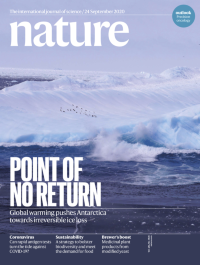Volume 585
-
No. 7826 24 September 2020
Point of no returnMore than half of Earth’s freshwater resources are held frozen in the Antarctic Ice Sheet, making the ice sheet’s long-term stability crucial to limiting global sea-level rise. In this week’s issue, Ricarda Winkelmann and her colleagues present model results that reveal how vulnerable the ice sheet is to climate change. The researchers show that as Earth’s climate becomes warmer, the ice sheet becomes progressively more sensitive to a given amount of warming. Even more concerning is the fact that, if warming levels persist, to restore the ice sheet to its current form would require more than just a reversion in temperature to the present-day level, it needs a cooling to lower than pre-industrial levels. The results suggest that, if the limits on warming set out in the Paris Agreement are not met, Antarctica’s long-term contribution to sea levels will dramatically increase and will be close to impossible to reverse.
Career Guide
-
No. 7825 17 September 2020
Viking voyagersThe cover shows the Sea Stallion, the world’s largest Viking ship reconstruction. The maritime expansion of Scandinavian populations during the Viking Age (around AD 750–1050) altered the political, cultural and demographic map of Europe. In this week’s issue, Eske Willerslev and his colleagues explore the genomic history of this period. The researchers sequenced the genomes of 442 people from across Europe and Greenland, covering the Bronze Age (around 2400 BC) to the Early Modern period (around AD 1600). They found substantial gene flow into Scandinavia from the south and east. They also identified distinct Viking movements around the continent: Danish Vikings headed for England, Swedish Vikings went east to the Baltics, and Norwegian Vikings travelled to Ireland, Iceland and Greenland, while newcomers were also entering Scandinavia from the west. Sequencing the genomes of 34 individuals from a Viking burial site in Salme, Estonia, the team identified four brothers who had been buried side by side. Close kin of this family group were also found hundreds of kilometres away, illustrating the mobility that characterized the Viking Age.
-
No. 7824 10 September 2020
Galactic coronaeThe Large and Small Magellanic Clouds are satellite galaxies of the Milky Way. They are surrounded by a high-velocity gaseous structure called the Magellanic Stream, which consists of gas stripped from both clouds. So far, simulations have been unable to reconcile observations with a complete picture of how the stream was formed. In this week’s issue, Elena D’Onghia and her colleagues present a model that potentially resolves this conundrum. By embedding the Large Magellanic Cloud in a corona of ionized gas, the researchers were able to simulate the Magellanic Stream accurately and explain its structure. The cover image shows the Large and Small Magellanic Clouds as they would appear if the gas around them was visible to the naked eye.
-
No. 7823 3 September 2020
Seeds of changeThe cover shows a silvereye (Zosterops lateralis), a bird native to New Zealand, perched on Chilean rhubarb (Gunnera tinctoria), a species that has been introduced to the country. Trade and transportation have helped to accelerate the introduction of species, both plant and animal, to new regions. In this week’s issue, Evan Fricke and Jens-Christian Svenning analyse the effects such introductions have on the mutualistic networks of fleshy-fruited plants and the animals that eat those fruits and so disperse the seeds. The researchers looked at 410 local networks, encompassing 24,455 unique pair interactions between 1,631 animal and 3,208 plant species. They found that introduced species blur the biogeographical patterns of the global network, and disproportionately facilitate the success of other introduced species. As a result, the researchers say, the resilience of local ecosystems is increasingly at risk from biotic homogenization.




